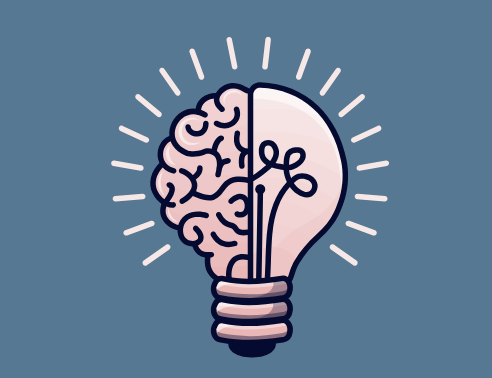How Motivation Works in the Brain – Exploring the Science
Have you ever wondered why some days you’re full of energy to accomplish your goals, while on others, you struggle to get started?
The secret lies in your brain. We’ll uncover how motivation works in the brain: exploring the science behind it, including the brain’s reward system, dopamine, and other critical factors.
By understanding these mechanisms, you can learn to harness your motivation more effectively.
What Is Motivation?
Motivation is the driving force that compels you to act. Whether it’s working toward a reward, avoiding a negative consequence, or simply pursuing something you enjoy, motivation pushes you forward.
It can be intrinsic (driven by internal desires, like the joy of learning) or extrinsic (driven by external rewards, like money or recognition).
At its core, motivation isn’t just about willpower it’s deeply tied to the workings of your brain.
Which Part of Your Brain Is Involved in Motivation?
The Reward System
Your brain’s reward system plays a major role in driving motivation. Here’s how it works:
- Dopamine: This neurotransmitter acts as a messenger, signaling the anticipation of a reward. When you visualize achieving a goal, dopamine is released, making you feel excited and driven.
- Nucleus Accumbens: This part of the brain responds to dopamine, creating feelings of pleasure and reward.
- Ventral Tegmental Area (VTA): This is where dopamine is produced and then sent to other brain regions, fueling motivation.
The Prefrontal Cortex
This part of the brain helps you plan and stay organized. It works like a control center, deciding which tasks are most important and helping you focus on long-term goals.
When you make progress, the prefrontal cortex sends signals to release dopamine, reinforcing positive behavior.
The Amygdala
The amygdala processes emotions, including fear and pleasure. It can either encourage motivation (e.g., working toward a reward) or trigger avoidance (e.g., avoiding failure).
Intrinsic vs. Extrinsic Motivation
Motivation comes in two forms:
- Intrinsic Motivation: You do something because you genuinely enjoy it or find it meaningful (e.g., painting for fun).
- Extrinsic Motivation: You’re driven by external rewards or consequences (e.g., working for a paycheck).
Both types play a role in your life, but intrinsic motivation often leads to greater satisfaction and sustained effort.
How Dopamine Drives Motivation
Dopamine is the star player in your brain’s motivation game. Here’s how it works:

- Anticipating Rewards: When you visualize finishing a project or achieving a goal, your brain releases dopamine. This creates a “feel-good” sensation that pushes you to act.
- Feedback Loop: Each small accomplishment (e.g., checking off a task) triggers dopamine, encouraging you to keep going.
- Motivational Salience: Dopamine tells your brain which tasks are most important and worth pursuing.
Tip: Set small, achievable goals to keep dopamine flowing and maintain motivation.
EQ vs. IQ: Which Should You Leverage When?
When we discuss EQ vs IQ In Motivation, It is influenced not just by your brain’s biology but also by your emotional and intellectual abilities:
- IQ (Intelligence Quotient): Helps with logical problem-solving and planning your goals.
- EQ (Emotional Quotient): Helps you manage emotions, overcome obstacles, and stay resilient when motivation dips.
When working on motivation, leverage IQ to create a clear plan, but rely on EQ to navigate challenges and maintain emotional balance.
How to Boost Your Motivation Naturally
Set Clear Goals
- Break big tasks into smaller, manageable steps.
- Write down your goals and visualize completing them.
Use Positive Reinforcement
- Reward yourself for progress, no matter how small.
- Celebrate milestones to trigger dopamine and build momentum.
Stay Active
- Exercise boosts dopamine and reduces stress, making it easier to stay motivated.
Surround Yourself With Positivity
- Spend time with supportive people who encourage your goals.
- Create an environment that inspires productivity.
Practice Self-Reflection
- Take time to evaluate your progress and adjust your strategies.
- Be honest about what’s working and what’s not.
Common Mistakes to Avoid
Setting Unrealistic Goals
Unattainable goals can lead to frustration and loss of motivation. Start small and scale up.
Ignoring Rest
Burnout can kill motivation. Schedule breaks to recharge your mind and body.
Procrastination
Waiting for the “perfect” moment often leads to inaction. Start now, even if progress is slow.
Tips to Overcome a Lack of Motivation
- Visualize Success: Imagine how achieving your goals will feel.
- Use a Timer: Work in short bursts (e.g., 25 minutes) to stay focused.
- Stay Consistent: Even small, daily actions can lead to big results over time.
FAQs
Which part of the brain releases dopamine?
Dopamine is primarily released by the Ventral Tegmental Area (VTA) and then sent to other parts of the brain, such as the nucleus accumbens and prefrontal cortex.
Can you increase motivation artificially?
While motivation can be temporarily boosted by external rewards, sustainable motivation comes from setting meaningful goals and reinforcing positive habits.
Why do I lose motivation so quickly?
This could be due to unrealistic expectations, lack of rest, or insufficient rewards. Reassess your goals and ensure you’re celebrating small wins.
Conclusion: How Motivation Works in the Brain: Exploring the Science
Motivation is deeply rooted in your brain’s reward system, with dopamine playing a crucial role. Understanding how motivation works in the brain: exploring the science can help you unlock your full potential.
By setting clear goals, leveraging both intrinsic and extrinsic motivation, and balancing EQ with IQ, you can take charge of your life and achieve your dreams.
Start small, stay consistent, and let your brain’s natural systems guide you toward success!







